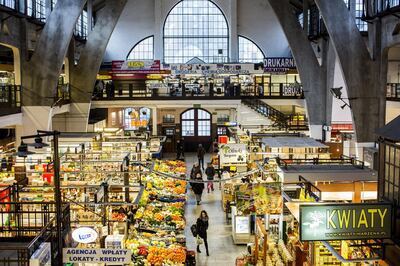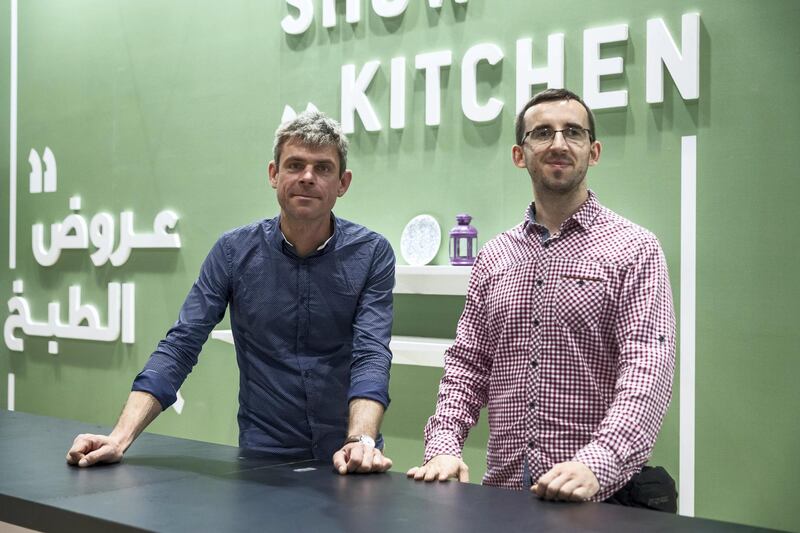If you walk into a supermarket in Poland today, intending to buy apples, you might have to choose between three or four varieties, five, tops.
Not so 400 years ago, says Maciej Nowicki, the head chef of the historical re-enactment department at the Museum of King Jan III’s Palace at Wilanow in Warsaw.
Centuries ago, there would have been anything between 140 to 160 varieties of apples alone. "Let's not get started on the carrots, or the butternut squash, or even the many types of pumpkins that would have been available," he says.
It is fascinating tidbits like these that Nowicki, with his team, will be sharing with those at the Abu Dhabi International Book Fair this weekend, where Poland is the Guest of Honour for the duration of the literary festival.
As someone whose job it is to dig deep into the culinary identity of his country, and who has donned the hats of historian and culinary artist, Nowicki's passion is to understand, then explain, the gastronomy of Poland.
Working with Professor Jaroslaw Dumanowski, who is also at the book fair and who revives neglected food traditions as a specialist in food history and old culinary texts as the originator of the Monumenta Poloniae Culinaria series of seven cook books published by the museum, Nowicki blend his degree in history with a 20-year career spent cooking modern European cuisine in London and Paris.
Dumanowski edited and published the first Polish culinary book he could find, written back in 1682 by Stanislaw Czerniecki.
“Czerniecki was a master chef of a wealthy aristocratic family in Poland, and he wrote the book for other chefs,” says Nowicki. This meant that the recipes were jotted down to list the ingredients, but never the quantities. “He assumed chefs would know the amounts so he did not include how much flour, or how much of a certain spice.”
Part of Nowicki's job is to spend time in the museum's laboratory experimenting with the recipes, cooking them repeatedly until he reaches the best possible outcome in terms of flavour, even if it means trying out a recipe 100 times or more.
“What I do is a kind of translation,” he says. “I am translating Polish food from 400 years ago to something we can understand today.”
Three times a week, Nowicki leads school children visiting the museum on field trips through the history of Polish cuisine, and then conducts a workshop where he teaches them how to cook an old recipe, before they all sit down together and dine on what they cooked. It is, essentially, an exercise in reenactment.
“We are developing children’s sense of taste and flavour; it’s not just about history. We teach them about different cooking techniques and the different meanings
of taste.”
Taste, he says, changed over the years. What tastes right to your grandmother or mother might not taste right to you.

Not having quantities to fall back on also poses a problem. “Centuries ago, if you tell me make this dish salty or put more vinegar or put more sugar or cinnamon, the ‘more’ will be a bit different than now, because if you don’t have the quantities, how can you guess what was considered salty or tasty or sour or sweet for people? It’s a completely different sense of flavour.”
Then, there's the lack of produce available today, which makes it impossible to recreate a recipe accurately.
“The biodiversity of centuries ago is nothing like the monoculture of today,” says Nowicki. “There is a whole world of forgotten produce and varieties of vegetables and types of birds that we no longer have access to.”
Not to mention, he says, that the food cooked 400 years ago would most likely be inconsumable today, whether because we are unaccustomed to the way food was presented back then – with fish dressed up to look like meat, for example – or because our palettes are not used to the flavour combinations.
“For example, a classic recipe from the 17th century is sturgeon in gingerbread,” says Nowicki. “This is not the classic gingerbread we know today as a dessert. It’s spicier and a very hard bread full of cinnamon and cloves and spices, and a lot of pepper.”
Nowicki reinterprets the ancient recipes so they are edible today, and
his sous chef, Norbert Sokolowski, also works on historical culinary reconstructions based on the oldest Polish cookbooks published by the museum. The biggest challenge the two men face, as they conduct their workshops and work on introducing ancient recipes to visitors of the museum, is changing presumptions.
“A Pole, unlike a foreigner, will expect a traditional dish to taste a certain way, and won’t like that which is not familiar,” says Sokolowski, which he says is often a problem they face with the children, who only like what they know.
One dish they often fall back on during the workshop is a soup called Nothing Soup. It’s actually a dessert, close in consistency to what creme brulee is like after it cools down. The soup is milk thickened by egg yolk and sugar, and then in goes some almond flakes and strawberries – or whatever berry or fruit is in season.
“This is a classic recipe from the beginning of the 20th century,” says Nowicki. “Cooking in the past was all about what was in season. There were no shops where you could go get strawberries whenever you wanted. Or a piece of chicken breast wrapped in cling film.”
Only wealthier aristocracy in continental Europe could afford to eat meat three times a week, he says. Killing chickens too often would mean no eggs; killing a cow for beef would mean no milk. “People were very careful and there was moderation in what they ate. Meat was a delicacy back then.”
In fact, he points out, 400 years ago, Poland was a very religious country, with fasting observed for 200 days out of the year. “People were not allowed to touch meat for religious purposes, not even butter. People back then were mostly vegetarians, and could only eat fish.”
And because it was the Baroque period, where theatrical habits were rife, chefs would go out of their way to dress up their dishes and make a fish look like a bird
or meat.
Nowicki, understandably, finds it all intriguing. “Our relationship with food is a fascinating look into history and speaks so much about our culture; it’s crucial that we share this knowledge.”
Two sessions on Polish Taste From The Past will be led by Nowicki and his team at the Show Kitchen area of the Abu Dhabi International Book Fair held at Adnec. The first is on Friday from 4:30pm to 6pm, and the second on Saturday from 8pm to 9.30pm
What you will taste
Titled Polish Taste From The Past, the Show Kitchen event at the book fair will begin with a short lecture from Professor Jaroslaw Dumanowski, who will explain the differences in Polish cuisine today compared 400 years ago. Then, Chef Maciej Nowicki and his sous chef, Norbert Sokolowski, will prepare three traditional Polish dishes.
“We will begin with Chodec,” say Nowicki, which he describes as a thick, cold soup quite popular in Poland during the warmer weather. Beetroots that have been steamed in water will be mixed with natural yoghurt, as well as cucumbers, radishes, chives, horseradish and fresh dill. “The soup will have an interesting red colour because we will use some of the water that we boiled the beets in,” says Nowicki. “The result is the crunch of the al dente vegetables with the cold yoghurt, very refreshing stuff.”
For the main course, the chefs will prepare Allaputrina, a type of Polish pate similar to the look of French terrine.
“It is made out of four or five types of meat; typically, goose, duck, chicken and beef,” he says. “Each are usually cooked separately then put together and mixed with nuts like almonds and pistachios, as well as dried fruit like raisins and some cinnamon and saffron, and steamed. We even include dates.” The Allaputrina is then served with apple mustard, which is cooked apples mixed with wholegrain mustard and a little vinegar.
Dessert will be Arkas, which is semolina cooked in milk and then blended well with honey and lime juice and cooled before serving. “The end result, which has the consistency of pudding, it a little sweet and a little sour as well,” says Nowicki.
___________________
Read more:
[ My key ingredient: lobster ]
[ A fresh take on fruit and vegetables ]
[ How to make ... La Petite Maison's Ragout Pappardelle ]
___________________










